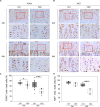G-Protein-Coupled Estrogen Receptor-1 Positively Regulates the Growth Plate Chondrocyte Proliferation in Female Pubertal Mice
- PMID: 34490260
- PMCID: PMC8417792
- DOI: 10.3389/fcell.2021.710664
G-Protein-Coupled Estrogen Receptor-1 Positively Regulates the Growth Plate Chondrocyte Proliferation in Female Pubertal Mice
Abstract
Estrogen enhances long bone longitudinal growth during early puberty. Growth plate chondrocytes are the main cells that contribute to long bone elongation. The role of G-protein-coupled estrogen receptor-1 (GPER-1) in regulating growth plate chondrocyte function remains unclear. In the present study, we generated chondrocyte-specific GPER-1 knockout (CKO) mice to investigate the effect of GPER-1 in growth plate chondrocytes. In control mice, GPER-1 was highly expressed in the growth plates of 4- and 8-week-old mice, with a gradual decline through 12 to 16 weeks. In CKO mice, the GPER-1 expression in growth plate chondrocytes was significantly lower than that in the control mice (80% decrease). The CKO mice also showed a decrease in body length (crown-rump length), body weight, and the length of tibias and femurs at 8 weeks. More importantly, the cell number and thickness of the proliferative zone of the growth plate, as well as the thickness of primary spongiosa and length of metaphysis plus diaphysis in tibias of CKO mice, were significantly decreased compared with those of the control mice. Furthermore, there was also a considerable reduction in the number of proliferating cell nuclear antigens and Ki67-stained proliferating chondrocytes in the tibia growth plate in the CKO mice. The chondrocyte proliferation mediated by GPER-1 was further demonstrated via treatment with a GPER-1 antagonist in cultured epiphyseal cartilage. This study demonstrates that GPER-1 positively regulates chondrocyte proliferation at the growth plate during early puberty and contributes to the longitudinal growth of long bones.
Keywords: G-protein-coupled estrogen receptor-1; bone growth; chondrocyte-specific knockout mice; estrogen receptor; long bone elongation.
Copyright © 2021 Chou, Chuang, Chen, Ho and Chang.
Conflict of interest statement
The authors declare that the research was conducted in the absence of any commercial or financial relationships that could be construed as a potential conflict of interest.
Figures






Similar articles
-
G-protein-coupled estrogen receptor-1 facilitates chondrocyte proliferation in pubertal epiphyseal growth plate via PTHrP/Ihh regulation.Bone Joint Res. 2025 Jul 1;14(7):589-600. doi: 10.1302/2046-3758.147.BJR-2024-0347.R1. Bone Joint Res. 2025. PMID: 40588242 Free PMC article.
-
G Protein-Coupled Estrogen Receptor Mediates Cell Proliferation through the cAMP/PKA/CREB Pathway in Murine Bone Marrow Mesenchymal Stem Cells.Int J Mol Sci. 2020 Sep 5;21(18):6490. doi: 10.3390/ijms21186490. Int J Mol Sci. 2020. PMID: 32899453 Free PMC article.
-
Chondrocyte-specific knockout of the G protein G(s)alpha leads to epiphyseal and growth plate abnormalities and ectopic chondrocyte formation.J Bone Miner Res. 2005 Apr;20(4):663-71. doi: 10.1359/JBMR.041210. Epub 2004 Dec 6. J Bone Miner Res. 2005. PMID: 15765186
-
Conditional Deletion of Prolyl Hydroxylase Domain-Containing Protein 2 (Phd2) Gene Reveals Its Essential Role in Chondrocyte Function and Endochondral Bone Formation.Endocrinology. 2016 Jan;157(1):127-40. doi: 10.1210/en.2015-1473. Epub 2015 Nov 12. Endocrinology. 2016. PMID: 26562260 Free PMC article.
-
The role of estrogen receptor-α and its activation function-1 for growth plate closure in female mice.Am J Physiol Endocrinol Metab. 2012 Jun 1;302(11):E1381-9. doi: 10.1152/ajpendo.00646.2011. Epub 2012 Mar 13. Am J Physiol Endocrinol Metab. 2012. PMID: 22414805 Free PMC article.
Cited by
-
Sex dependent effects of GPR109A gene deletion in myeloid cells on bone development in mice.Sci Rep. 2025 Jul 22;15(1):26515. doi: 10.1038/s41598-025-12017-3. Sci Rep. 2025. PMID: 40691257 Free PMC article.
-
Sex-dependent effect of GPR109A gene deletion in myeloid cells on bone development in mice.Res Sq [Preprint]. 2025 Apr 2:rs.3.rs-6206075. doi: 10.21203/rs.3.rs-6206075/v1. Res Sq. 2025. Update in: Sci Rep. 2025 Jul 22;15(1):26515. doi: 10.1038/s41598-025-12017-3. PMID: 40235504 Free PMC article. Updated. Preprint.
-
Ablation of Discoidin Domain Receptor 1 Provokes an Osteopenic Phenotype by Regulating Osteoblast/Osteocyte Autophagy and Apoptosis.Biomedicines. 2022 Sep 2;10(9):2173. doi: 10.3390/biomedicines10092173. Biomedicines. 2022. PMID: 36140274 Free PMC article.
-
Editorial: Cell Biology, Physiology and Molecular Pharmacology of G Protein Coupled Receptors.Front Cell Dev Biol. 2021 Dec 9;9:815291. doi: 10.3389/fcell.2021.815291. eCollection 2021. Front Cell Dev Biol. 2021. PMID: 34957128 Free PMC article. No abstract available.
-
Estradiol Inhibits ER Stress-Induced Apoptosis in Chondrocytes and Contributes to a Reduced Osteoarthritic Cartilage Degeneration in Female Mice.Front Cell Dev Biol. 2022 May 20;10:913118. doi: 10.3389/fcell.2022.913118. eCollection 2022. Front Cell Dev Biol. 2022. PMID: 35669511 Free PMC article.
References
-
- Chagin A. S., Savendahl L. (2007a). Estrogens and growth: review. Pediatr. Endocrinol. Rev. 4 329–334. - PubMed
LinkOut - more resources
Full Text Sources
Molecular Biology Databases

